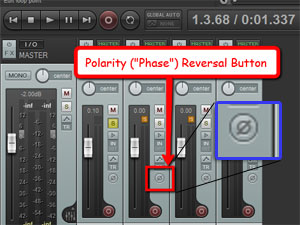The term gain stages basically refers to all the points in an audio set-up (either for recording or doing live sound) where something can be turned up. And if it can be turned up, that means it cam possibly distort, which we will state for the record is bad – in any case where you aren’t doing it on purpose for some effect. The trick is to make sure you have enough signal at every stage but not too much, or you get distortion. But also not too little at any stage, or the stage after it will have to be turned up too loud to compensate, which can increase noise like hiss and hum.
Let’s look at an example. In a live sound situation (where a band’s microphones and instruments are all going through a mixer and PA system) an electric guitar’s first gain stage is the volume knob on the guitar itself. Next in the chain is the amplifier, which also has volume and gain knobs. Next comes the mixer, which will have at least two gain stages – the input gain/trim and the master output volume. But there is also the channel strip fader, and if you run the electric guitar channel through any effects, there is another gain stage. And some PA amplifiers and speakers also have volume controls, so there is another couple of gain stages.
So in order to get the best sound out of any audio source in both recording and live sound, you want to make sure you have a healthy signal level, but nothing that will cause any gain stage to be so loud that any of the audio distorts or clips anywhere in the signal chain. That process of ensuring the proper amount of signal without going over the “red line” anywhere is called “gain staging.”
In recording vocals, the main goal is to make sure your microphone sends the right signal level to the preamp (this can be adjusted on some microphones by a pad switch), which then sends the right amount of signal to the recorder or computer. Most audio interface units have a knob to control this level.
Here’s a video from Wink Sound that shows you an example with an electric guitar in a computer recording set-up.
What Is A Delay Throw Effect?
One of the many common effect used primarily in music is called a delay. It might help if you call it an echo, because what a delay does is create a copy of part or all of a piece of audio and then repeat it just after the original. It “delays” the repeat by some set amount, usually a fraction of a second.
Now you can attach this effect to an entire vocal track, or you can just treat a single word or phrase in the track. The latter is called a “delay throw.”
So how that would sound is that the audio – let’s say a vocal – would be merrily singing along with no echo (delay). But then at some specific point in the song, maybe right before a chorus to build up anticipation or some other emotional effect, you decide to apply the delay effect to just one word or a short 2-3 word phrase.
In the following video by Dezz Asante, he shows you how to do this using Cubase recording software. Of course you can do the same thing in other DAW (digital audio workstation) programs. In Reaper there a several ways to do it. You can use an effect buss and an automation envelope line like Dezz does in the video. But in Reaper I would be more likely to slice out the audio I want (Shift-Ctrl-S) to create a new audio item, and then simply insert the delay effect onto the new item.
See the aforementioned video below:
10 Fascinating Things About Sound That You Probably Don't Know
Here is a really interesting post about a presentation made by international speaker and sound/audio expert Julian Treasure, author of the “Sound Business” blog. The video of that presentation can be seen below.
Treasure offers 10 things “you didn’t know about sound,” some of which are absolutely true, and some of which are a bit theoretical and heady – such as “your body is a chord.” Treasure makes some claims in this presentation about sound and its relationship to health that are followed by the statement – “…I hope [this] will be tested by researchers.“So just be aware of that.
One of the things he talks about is the auditory frequency range of humans – 20 Hz to 20,000 Hz – which is definitely true and impacts a lot of the standards for audio recording, especially things like digital audio and A-D (analog-to-digital) converters, and most specifically, sampling frequency. See our article What Is Sampling Frequency?
Anyway, the article is here: http://edition.cnn.com/2010/OPINION/10/10/treasure.sound/index.html
And the video of the presentation is below.
Using The Polarity Switch To Optimize Live Drum Sound
 Most mixers have a switch on each channel that will reverse the polarity (often referred to as “phase,” which is not technically correct). To understand polarity, remember that sound happens in waves caused by air moving back and forth – away and toward a microphone. When a blast of air comes toward a microphone, a positive bit of air pressure is picked up. When, an instant later, the wave moves back away from the mic, you get negative pressure picked up. What the polarity switch does is flip them – a positive pressure becomes negative, and vice versa.
Most mixers have a switch on each channel that will reverse the polarity (often referred to as “phase,” which is not technically correct). To understand polarity, remember that sound happens in waves caused by air moving back and forth – away and toward a microphone. When a blast of air comes toward a microphone, a positive bit of air pressure is picked up. When, an instant later, the wave moves back away from the mic, you get negative pressure picked up. What the polarity switch does is flip them – a positive pressure becomes negative, and vice versa.
One very common use for this switch is when you use 2 mics on a snare drum, one on the top and one on the bottom. When the snare drum is hit, the skin moves in and away from a mic that is pointing at the top drum skin – a negative polarity. That same hit causes the bottom head to move outward – toward the bottom mic – a positive pressure. When these two bits of sound wave are put together in the speakers, one will push the speaker out and one will suck it in. So certain frequencies will be negated in that transaction. So it’s almost automatic for mix and live engineers to flip the polarity on the bottom mic so that the drum hit causes both heads to be negative and they will add together instead of subtract audio. This usually results in a better sounding drum with more low-frequency punch.
In this article by Dave Rat, he talks about the use of the polarity switch – when to reverse it and when not to – in order to get a great drum kit sound. Though it is in the “Live Sound” section of the Pro Sound Web Site), the article doesn’t mention it explicitly, but since he mentions the polarity in conjunction with drum monitor speakers, it’s pretty clear he’s talking about the drums in a live music situation. See the full article below:
Article for polarity for drums
Keeping The Electric Guitar Out Of The Way Of The Vocal
 In a rock song, you want powerful and up-front electric guitar – that’s what rock is all about, right? Unfortunately electric guitars and voices usually occupy the same spot on the frequency spectrum around 3 KHz. So the guitar often overpowers the vocal. Well, when we’re mixing, if we want to turn one thing down in relation to another (that’s what mixing is all about, right?), we can just move a slider on, say, the guitar track until it’s low enough that the vocal can be heard clearly. The only problem is that by the time you get a clear vocal all the way through the song, you’ve turned the guitar down too much for it to be punchy and powerful.
In a rock song, you want powerful and up-front electric guitar – that’s what rock is all about, right? Unfortunately electric guitars and voices usually occupy the same spot on the frequency spectrum around 3 KHz. So the guitar often overpowers the vocal. Well, when we’re mixing, if we want to turn one thing down in relation to another (that’s what mixing is all about, right?), we can just move a slider on, say, the guitar track until it’s low enough that the vocal can be heard clearly. The only problem is that by the time you get a clear vocal all the way through the song, you’ve turned the guitar down too much for it to be punchy and powerful.
Of course you can use EQ to reduce the guitar’s frequency at around 3 KHz, which will help. But what if that isn’t enough? It often isn’t. Well that is where “ducking” comes in (which can be used for any and all instruments – not just guitar of course). See my article on ducking here: What is Ducking In Audio Recording?, where I show you how to do ducking in Reaper recording software. This technique uses a compressor to automatically push down the level of the guitar (or any instrument track), but ONLY when the singer is singing. You could do this manually if you are very, very patient. I highlighted an article earlier this week showing you in a video how to do this in Making The Vocal Track Sit Well In The Mix .
Here is an article by Bjorgvin Benediktsson, complete with audio examples, that talks about “side-chain” compression (the way you make ducking happen) to get the guitar out of the way of the vocal in a rock mix:
http://audio.tutsplus.com/tutorials/production/how-to-use-side-chain-compression-to-make-rock-guitars-stay-out-of-the-vocals-way/